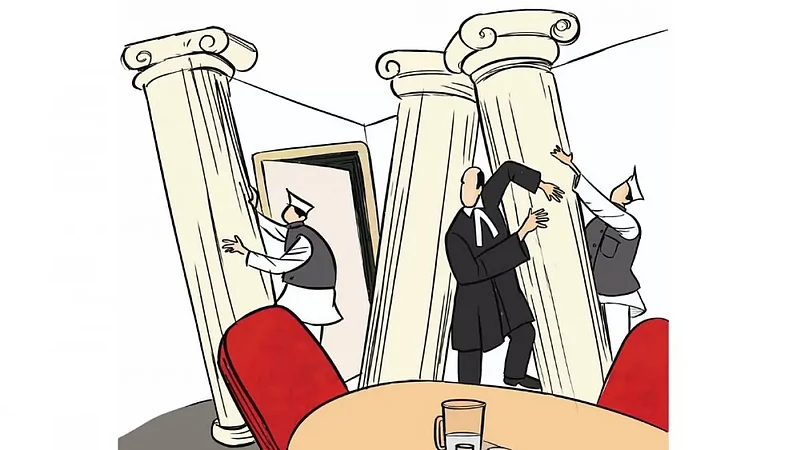Amidst the ongoing tussle between the Judiciary and the Executive, Supreme Court today took an unprecedented move as it uploaded the letters it has sent to the Central government reiterating three names that got earlier rejected for elevation to the High Courts. According to the rules, the Central government must accept the recommendations of the Supreme Court if it sends it for the second time.
The major revelation from the top court takes names of Saurabh Kirpal, Somasekhar Sundaresan and R John Sathyan who are to be elevated to the Delhi, Bombay and Madras High Courts respectively. In the case of Kirpal, who has long back come out as gay, the central government cited the ground of his sexual preference to deny him the recommended elevation. Notably, the government also referred to his partner who is a Swiss national to reject the SC’s suggestions. Kripal earlier while talking to a television channel said that he didn’t think that the government is ready to accept an openly gay person on the bench.
As per the revelation of the Supreme Court, the letter that the Central sent to the apex body rejecting Kripal’s elevation noted, “homosexuality stands decriminalised in India, nonetheless same-sex marriage still remains bereft of recognition either in codified statutory law or uncodified personal law in India.” The Centre also expressed its discontent over Kripal’s “ardent involvement and passionate attachment to the cause of gay rights”.
In response to it the SC notes, “As regards the second objection, it needs to be noted that the decisions of the Constitution Bench of this Court have established the constitutional position that every individual is entitled to maintain their own dignity and individuality, based on sexual orientation.”
The top court also rejects the ground of having a partner of Swiss National origin and citing precedence notes, “There is no reason to pre-suppose that the partner of the candidate, who is a Swiss National, would be inimically disposed to our country since the country of his origin is a friendly nation. Many persons in high positions including present and past holders of constitutional offices have and have had spouses who are foreign nationals.”
In the case of the rejection of Somasekhar Sundaresan’s elevation to the Bombay High Court on the ground of his opinions in the social media posts, the SC writes, “Having considered the objection to the candidature of Shri Somasekhar Sundaresan, the Collegium is of the view that the views on social media attributed to the candidate, do not furnish any foundation to infer that he is biased.”
Ruling out the allegations of bias against Sundaresan, the SC upheld the freedom of speech and expression and added, “All citizens have the right to free speech and expression under Article 19(1)(a) of the Constitution. Expression of views by a candidate does not disentitle him to hold a constitutional office so long as the person proposed for a judgeship is a person of competence, merit and integrity.”
The case of R. John Sathyan is also related to his critical comments against the Prime Minister. In their letter of rejection, the Centre cited the Intelligence Bureau (IB) report against the candidate that reads, “As per open sources, two posts made by him, i.e. sharing of an article published in ‘The Quint’, which was critical of the Prime Minister, Narendra Modi; and another post regarding committing of suicide by medical aspirant Anitha, who ended her life in 2017 since she was unable to clear NEET, portraying it as a killing by ‘political betrayal’ and a tag stating ‘shame of you India’ came to notice.”
The SC, nevertheless, rules out such allegations saying “Shri Sathyan belongs to the Christian community. The IB report notes that he does not have any overt political leanings. In this backdrop, the adverse comments of the IB extracted above in respect of posts made by him i.e. sharing an article published in ‘The Quint’ and another post regarding committing of suicide by a medical aspirant candidate in 2017 will not impinge on the suitability, character or integrity of Shri Sathyan.”
Interestingly, this revelation of the Supreme Court comes at a time when the law minister and the Vice President are having a tough time with the Judiciary. VP Jagdeep Dhankar recently even questioned the SC judgement on the Kesavananda Bharati case in 1973 that actually fixed the basic structure doctrine.
At this moment, Outlook revisits its issue titled When Pillars Collide dated January 2, 2023, where we tried to understand the root of the tussle between the Executive and Judiciary. While writing for us Saurabh Kirpal noted, “We must, in these times, remember the lessons of the past to know that an almighty clash between the different branches of the State does not augur well for the country.”
Commenting on the collegium controversy former Justice Deepak Gupta pointed out, “While the collegium is criticised for not being transparent, the functioning of the government is totally opaque.” In the debate, we also heard a strong voice of support for collegium from Nizam Pasha who while criticising authoritarian rules noted, “But as majorities in the legislature have become absolute and power has become concentrated in the hands of one party, judicial appointments by the judiciary, even with all its opaqueness, nepotism and biases, is the only hope we have against authoritarian rule.”
With these and many more, we tried to begin the conversation that deals with the limits of both the executive and judiciary. Are the pillars colliding again?

















